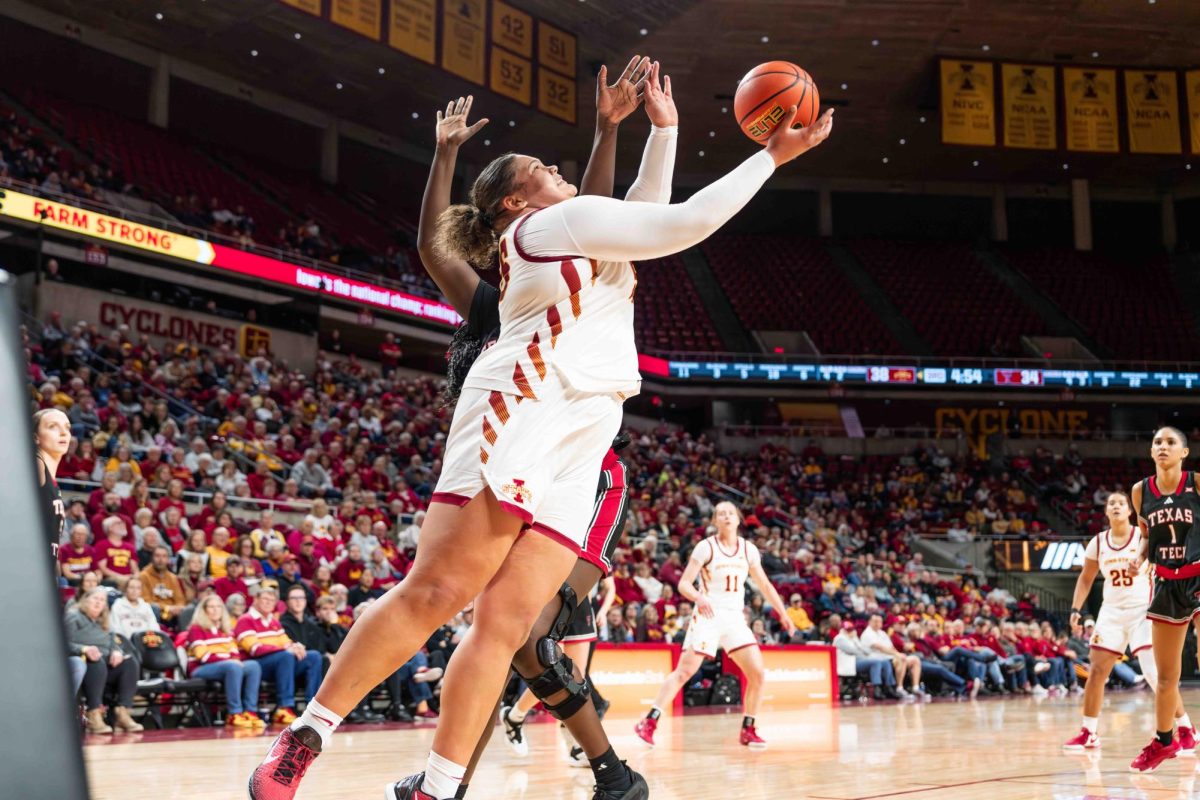Ames pioneers sight restoration
April 29, 2007
Bob’s life was like that of any other dog – eat, sleep, chase the ball, chase the squirrels, etc.
But one day a few weeks ago, Bob was suddenly unable to fetch his favorite tennis ball and was incapable of navigating his home without bumping into objects. Complete blindness had settled in nearly overnight.
“We were sad,” said Bob’s owner, Dave Lester of Slater. “It was just so quick.”
A debilitating puzzle
Bob had fallen victim to Sudden Acquired Retinal Degeneration Syndrome, or SARDS, a disease that claims the sight of 2,000 to 4,000 dogs each year.
“This is a very unique disease,” said Sinisa Grozdanic, assistant professor of veterinary clinical sciences whose specialty is opthalmology . “Pretty much the name tells a lot about the disease. These dogs are healthy, happy; the next morning the owners wake up and the dog is completely blind, bumping into all objects.”
Grozdanic said the retinas, the layers of light-receiving cells in the back of the eye, of a suddenly blind dog will appear perfectly intact and normal upon examination by a veterinarian. The retina will begin to visibly degenerate only after subsequent months of blindness.
“The biggest challenge for the regular veterinarians is when they look at the dog they obviously see the dog is blind, but when they look in the eyes they do not see any abnormalities,” Grozdanic said.
“That creates a problem in terms of diagnosis because you start to think, ‘Well, maybe it’s not related to the eyes, maybe it’s related to the brain.”
The key method of SARDS diagnosis is through a test called electroretinography, which measures the electrical activity of cells in the eye. The cells of the retina translate light into electrical signals which are sent to the brain to be processed as images.
“Basically, electrical activity in the dogs can be elicited by light, so you shine a light in the retina, and if you have a contact lens type of electrode, you can record that electrical activity,” Grozdanic said.
An initially undamaged retina and a complete lack of electrical activity is indicative of SARDS.
video: A dog suffering from SARDS stumbles around a room full of objects, hindered by blindness.
video: Bob the dog successfully navigates the same room after being treated for the same blindness.
Connections and clues
When Grozdanic began looking more at this problem two years ago, most of the literature regarding SARDS described pupil constriction in SARDS-afflicted dogs as absent or poor; this observation seemed to make sense because the function of the pupil is to shrink or expand to regulate the amount of light entering the eye in response to retinal activity. Poor pupil activity is indicative of low retinal response to light.
However, when Grozdanic experimented with shining different types of colored light into the eyes of SARDS dogs, he got some interesting results.
“If you use a red light, that pupil will not constrict at all; it will stay big and dilated. But if you use a blue light, the pupil will constrict completely like it’s a normal, healthy eye. It’s the same light intensity, just different wavelengths,” Grozdanic said. “When we saw this, we started to think, ‘Okay, this absolutely does not make any sense. That retina, according to electrical activity, is not working at all.'”
But these findings showed Grozdanic that something in the retina was indeed still functioning.
Grozdanic began collaborating with opthalmology researchers at the University of Iowa and the Veteran’s Administration Medical Center, including Dr. Randy Kardon, director of neuro-ophthamology service and professor of ophthalmology at the University of Iowa . Together, they noticed similarities between dogs afflicted with SARDS and humans with types of sudden onset blindness brought on by cancer.
“What they realized is that some of these cancers will create strong a stimulus for the immune system, and the immune system will build antibodies against the cancer itself,” Grozdanic said. “But it seems that some of the cancer cells actually have the same antigens like antigens in the retina. So what they figured out is that these patients developed these relatively aggressive types of retinal diseases where they rapidly lose vision, and it’s related to the antibodies which are binding to the retina itself and then activating some component in the retina which can cause the retinal cells to die or stop functioning.”
This type of blindness, called immune mediated retinopathy, had been treated with varying degrees of success using intravenous immunoglobulins , for 10 to 15 years. These molecules, called IVIG, can help to regulate the behavior of the immune system.
“Basically, [immunoglobulins] are regular circulating globulins which are present in the circulation of every healthy human being,” Grozdanic said.
“The healthy globulins, which are continuously circulating in our body, are actually helping to control our immune system. . One of the hypotheses is that those free-circulating immunoglobulins are pretty much keeping our immune system in check.”
A partnership of research and hope
Since the IVIG therapy had helped humans recover at least partial sight, Grozdanic decided to try the treatment in a SARDS-afflicted canine. He filed for a protocol to begin the experimental treatment, and the university approved; now he only needed a dog with a recent SARDS diagnosis and an owner willing to make the attempt.
That was where Bob’s bad luck turned into an opportunity.
“Bob came to us two weeks ago and was diagnosed with SARDS,” Grozdanic said.
Ordinarily, upon diagnosis of SARDS, a vet could only tell a pet owner that the disease had no therapy and attempt to give comfort.
“After we found out, everything I looked at said, ‘no treatment, no treatment, no treatment,'” Lester said.
Lester brought Bob in to the Veterinary Teaching Hospital’s Small Animal Clinic, and Grozdanic asked if he was willing to try a new possible treatment.
Grozdanic had to not only warn Lester about the experimental nature of the therapy, but also the expense involved. IVIG products, derived from human blood plasma donations, are by no means cheap; for a medium-sized dog such as Bob, the price may be as high as $1600, Grozdanic said.
The dog must also be in otherwise good physical condition with no heart or kidney problems. Since only human IVIG products were available, Bob would be treated with immunoglobulins from a completely different species, and adverse reactions to the foreign immunoglobulins were a possibility.
But after previously having no options, Lester was willing to try.
“I just took him there and found out about the experimental treatment,” Lester said. “We said, ‘Let’s give it a shot.'”
Risking the odds
Before the treatment, Bob underwent extensive imaging and analysis of his eyes to make sure that he was a good candidate.
“We have state-of-the-art equipment for the imaging of dog eyes here at Iowa State. We have a pretty much unique laboratory with that diagnostic capability in terms of North America and probably the world,” Grozdanic said.
Iowa State’s multifocal electroretinography apparatus is indeed rare – Grozdanic said only a few vet schools have access to such a machine.
The multifocal aspect of this ERG machine means that the electrical activity in individual regions of the retina can be measured; a standard single-focus ERG can only register total activity. A multifocal ERG can better determine whether small regions of the retina are still active.
“We did a scan of the retina that showed that the retinal structure in Bob’s eyes was still very well preserved, then we knew, ‘Okay, if the retinal structure is still very well preserved, there is a chance we can remove the possible causative agent there, and maybe we’ll be able to regain some vision.'”
Lester dropped Bob off for a five-day hospital stay. He would receive the IVIG treatments on days one and three.
“We treated Bob with IVIG,” Grovdanic said, pointing to a graph of electrical response spikes from Bob’s retina, “[and] four days after we started with treatment, you can start to see the waves of electrical activity.”
Perhaps more striking was a comparison between a video of an untreated SARDS dog and a video of Bob. Both dogs were placed in a small office – orange cones, chairs and other objects scattered around the floor – and allowed to roam free.
The untreated dog acted like Bob did when Lester discovered he was blind, taking a few reluctant, sporadic steps and bumping into the obstacles.
Bob approached the same obstacles and deftly walked around them all, tail briskly wagging.
Making history & looking to the future
Bob’s recovery is historic; no other dog has ever recovered from SARDS in any capacity before.
“For the last 25 years it was considered incurable, until two weeks ago,” Grozdanic said.
“He is the first dog ever to have any functional visual recovery.”
Grozdanic emphasized that Bob probably didn’t recover all of his sight, but can see light and dark and make out larger objects again.
Even this amount of partial recovery has a huge significance, he said, and it’s possible Bob’s vision will gradually get even better as the IVIG continues to take effect.
“We immediately notified all of our colleagues about these positive things,” Grozdanic said. “Last week I think I had approximately 40 phone calls and e-mails from concerned owners wanting to bring their dogs.”
Grozdanic said in humans, IVIG treatments usually have to be readministered periodically to keep the immune system in check.
Since he doesn’t want to risk any sort of reaction to foreign immunoglobulins, he would like to eventually see a reliable canine source of immunoglobulins that would be a better match for Bob and other SARDS dogs.
“It’s a big waiting game to see for how long this treatment will work,” Grozdanic said.
Lester said he was very pleased with Bob’s recovery.
“We’re happy,” Lester said. “We’re hoping it gets a little better but we’re happy with what he’s got.”
He said Bob has been resuming some of his normal activities and can safely navigate around chairs and under the kitchen table again.
“Bob’s been doing good,” Lester said. “He’s a happy dog.”
Grozdanic said he has high hopes for the future of the treatment and said the breakthrough had an impact on him as well as the veterinary community.
“It’s been a huge lesson for me,” he said. “Every problem has a solution.”






